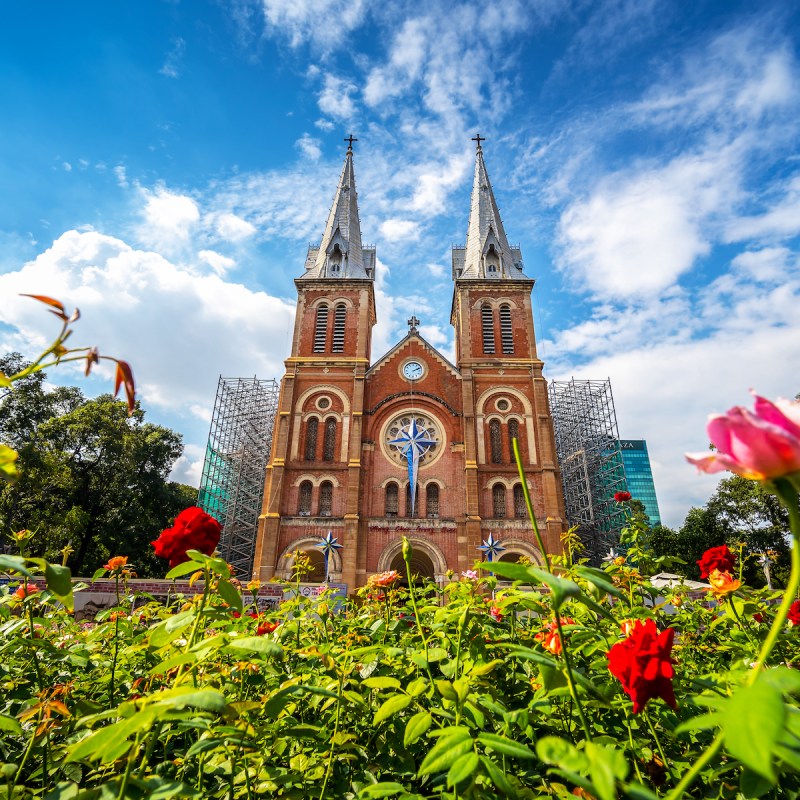
Ho Chi Minh City was formerly known as Saigon and is generally still referred to as Saigon by locals, expats, and visitors of a certain age, and I will continue to call it that as well here, if you don’t mind. It lies in the southeast of Vietnam, just north of the Mekong Delta. The largest and most populous city in Vietnam, with just under 10 million inhabitants, Saigon is an assault on all the senses and leaves visitors breathless with its onslaught of impressions.
Videos by TravelAwaits
Ignoring the wider city and concentrating on the old center by the loops of the Saigon River, visitors are confronted with countless mopeds filling the streets, electric cables hanging seemingly randomly alongside buildings, spanning streets and junctions, and a heady mix of old and new traditions and progress. The city is quite literally buzzing and is vibrant and historically rich with plenty to keep visitors busy for a few days.
Here are my favorite things to see and do in Saigon.

1. Historic Hotel Hopping
I might as well start with something really useful: where to stay. I stayed at the Hotel Majestic right by the river and at the corner of one of my favorite streets in Saigon — Dong Khoi (see more below). The hotel, opened in 1928, offers old-fashioned and slightly faded grandeur, a lovely pool, and one of the best roof terraces in town with great views across the river and skyline. Just along Dong Khoi, you come across the Hotel Grand Saigon, another 1930s historic and recently renovated hotel, and a few more steps along, you’ll see the gorgeous Hotel Continental Saigon. Opened in 1880, it is a wonderful building with so much history and will feel like a home away from home to those who have read Graham Greene’s The Quiet American. Each hotel is great to stay in, and, even more important, allows you to step outside into the bustle of the city and walk to the main attractions in the center. Once you choose one hotel, make sure you visit the others.

2. Dong Khoi Street
If you have decided to stay on Dong Khoi Street, you are in the heart of the city, with this being the oldest street in town. Here, you have shops — ranging from high-end luxury to tiny little stalls — selling, for example, Graham Greene’s locally printed books, making for a great souvenir. Old-fashioned and basic restaurants serving local phô soup nestle next to modern cafés. Try L’Usine, where you get a good breakfast and lunch, and drink your Vietnamese coffee while taking advantage of the café’s free Wi-Fi. Just walking up and down this street will give you such a great impression of the city, and I never tire of it. Just be careful with those mopeds.

3. Notre-Dame Cathedral Of Saigon
At the end of Dong Khoi Street stands the iconic red-brick Notre-Dame Cathedral. Even though it was only built in the late 1800s, it has long become the symbol of Saigon, with, on the weekends, countless brides and grooms posing under the tall and shade-giving trees next to the church. On the other side of the street, there is the Saigon Central Post Office, a grand Colonial building that is still a working post office and a good place to buy stamps for those old-fashioned postcards.
4. Independence Palace
A short walk to the left of the cathedral, you’ll find the gigantic complex of the Independence Palace, a rather ugly yet somehow intriguing-looking 1966-built edifice. Maybe it’s the palm trees on the roof making it look as if this might be a beach resort. Also known as the Reunification Palace, this complex played a significant role in Vietnam’s history, with the interior left as a time capsule, allowing you to learn about the Vietnam War. There are grand rooms, war rooms, an underground bunker, and a museum with interesting artifacts.
Behind the palace, within walking distance, lies the War Remnants Museum, allowing you to learn more and round things out historically.

5. The Cu Chi Tunnels
While we’re talking about the Vietnam War, the Cu Chi Tunnels — a vast underground network used by Vietnamese soldiers during the war — are worthwhile experiences for those interested. There are organized tours, picking you up from your hotel, allowing you to get more information from a local guide. But be warned that you will need to crawl through the very restrictive tunnels, making them inaccessible for those with bad knees or even subtle claustrophobia.
6. The Mekong Delta
The delta of the Mekong River is vast and utterly fascinating. It’s a huge part of Vietnam, taking over nearly the entire southern tip of Cambodia, with a landscape like no other. With its 15,600 square miles, it is the world’s third largest delta and is often called the rice bowl of Vietnam, as there are rice paddies everywhere across the delta. There are villages, floating markets, swamps, and pagodas, all dotted across the many river arms and countless islands and all best explored by boat.
Alternatively, or additionally, a river cruise on the Saigon River is lovely, especially at night over dinner. Saigon has a lot of high-rises that sparkle at night, making the cruise rather romantic. The skyscraper not to miss is the Bitexco Financial Tower, which has a fabulous viewing platform.

7. Ben Thanh Market
There is nothing quite like a traditional market to allow you to feel swallowed up by a different culture. The oldest and probably most famous market in Vietnam, rebuilt in 1870 by the French, is the Ben Thanh Market. It is a bustling market for both locals who come for fresh food products, clothing, and kitchenware and tourists who come for souvenirs. This is where you get practically everything, from art to useful stuff, terribly tacky knick-knacks to rather beautiful décor items, including an eminently collectible array of chopstick stands in all shapes and forms.
And, as long as you haggle, you can also get great bargains. Look out for lacquerware, which is simply stunning. I have to admit that I went so overboard buying lacquer art, chopstick rests, bowls, and even a large lacquer cabinet, that I had to arrange shipping for my purchases. But I have never regretted it; the items are still gorgeous. If you have fallen in love with lacquerware, why not visit a lacquer factory as part of a shopping tour? The eggshell pieces really did it for me.

8. Jade Emperor Pagoda
Located in a little green oasis right in the city, the Jade Emperor Pagoda is one of the most important Taoist temples in Saigon. Hidden within the lush vegetation, this intricate shrine complex is filled with mythical animals, real-life turtles, menacing Taoist warriors, imposing gods, and other statues. There is much to see and a great atmosphere — if at times the incense can become a little overwhelming — and to boot, it is free to enter. But there are donation boxes, so please make use of them for the upkeep of this lovely spot.
9. Food And Street Market Tour
One of my favorite things about Vietnam is the food. It’s where I first encountered phô soup, something I still eat regularly, and the spring rolls, fried or raw. Vietnamese cuisine is light, healthy, and simply delicious. Rather than chancing it, why not start with a food tour, learning and eating as you go? And, if you are on a budget, look out for the Vietnamese fast-food chain simply called Phô 24. Here, you get good food and it’s cheaply prepared. The setting is clean and modern, and, if you are lucky, they even have Wi-Fi.

